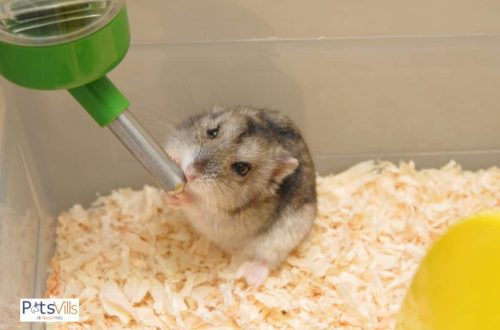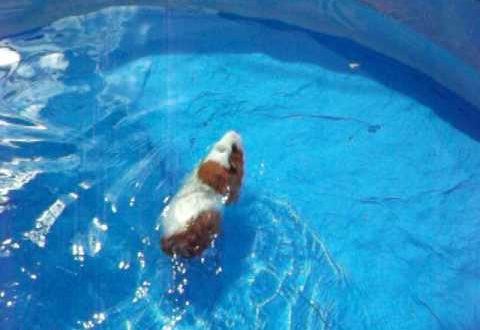
Breeding skinny guinea pigs
Skinnies are currently the most common breed of hairless guinea pigs, however, they are still considered a rare breed. Skinnies are almost completely bald, with only small patches of short, fluffy hair on the muzzle/head, shoulders, back, and ankles. And even the baldest of them still have a small amount of almost invisible fluff throughout the body, which makes them velvety and pleasant to the touch.
In fact, not much is known about skinnies, except that they first appeared in the laboratories of Canadian scientists engaged in dermatological research. For the first time pigs of this breed were introduced by Charles Rivers Laboratory (Canada) in 1976. At that time, all skinnies were white with red eyes. Since then, breeders have worked hard on them, crossing them from generation to generation with “wool” guinea pigs, using carriers of the skinny gene, and thus strengthening their immunity. The process is quite slow, but today, along with the white red-eyed variation, we have a variety of colors. Many people like the original skinny color, because the pigs are so pink!
At present, Skinnies are healthy and strong animals, and the breed is developing and progressing. In order to further expand and strengthen the gene pool, many breeders continue to breed using carriers. This explains to some extent why some animals are more “bald” today, while others still have some body hair.
Skinnies are currently the most common breed of hairless guinea pigs, however, they are still considered a rare breed. Skinnies are almost completely bald, with only small patches of short, fluffy hair on the muzzle/head, shoulders, back, and ankles. And even the baldest of them still have a small amount of almost invisible fluff throughout the body, which makes them velvety and pleasant to the touch.
In fact, not much is known about skinnies, except that they first appeared in the laboratories of Canadian scientists engaged in dermatological research. For the first time pigs of this breed were introduced by Charles Rivers Laboratory (Canada) in 1976. At that time, all skinnies were white with red eyes. Since then, breeders have worked hard on them, crossing them from generation to generation with “wool” guinea pigs, using carriers of the skinny gene, and thus strengthening their immunity. The process is quite slow, but today, along with the white red-eyed variation, we have a variety of colors. Many people like the original skinny color, because the pigs are so pink!
At present, Skinnies are healthy and strong animals, and the breed is developing and progressing. In order to further expand and strengthen the gene pool, many breeders continue to breed using carriers. This explains to some extent why some animals are more “bald” today, while others still have some body hair.
In some places, there is still information that skinnies often have health problems. However, by now the situation is already different, especially if you are dealing with a reputable experienced breeder who is responsible for breeding the breed, and does not pursue a greater degree of “baldness” in animals at the expense of their health and endurance.
Females are untied from 4-5 to 7-9 months. Males aged 3-6 months. The female should be given rest from childbirth for at least 5 months.
The skinny gene is recessive. When knitting skinny and skinny, you will always get skinny. When mating a skinny guinea pig to a coated guinea pig, you will get rough, curly-coated guinea pigs that carry the skinny gene. It’s impossible to tell exactly how many carriers are born until you test them by mating with a Skinny gilt. When mated with a skinny and a carrier, you can get 50% skinny gilts, but the percentage can be either less or more. Also, pigs born from mating with a carrier are not born hairless. They are born more woolly than completely hairless gilts. With subsequent matings of these pigs with skinny pigs, the hair will gradually thin out and in this way it is possible to achieve the appearance of babies completely without hair on the body.
In some places, there is still information that skinnies often have health problems. However, by now the situation is already different, especially if you are dealing with a reputable experienced breeder who is responsible for breeding the breed, and does not pursue a greater degree of “baldness” in animals at the expense of their health and endurance.
Females are untied from 4-5 to 7-9 months. Males aged 3-6 months. The female should be given rest from childbirth for at least 5 months.
The skinny gene is recessive. When knitting skinny and skinny, you will always get skinny. When mating a skinny guinea pig to a coated guinea pig, you will get rough, curly-coated guinea pigs that carry the skinny gene. It’s impossible to tell exactly how many carriers are born until you test them by mating with a Skinny gilt. When mated with a skinny and a carrier, you can get 50% skinny gilts, but the percentage can be either less or more. Also, pigs born from mating with a carrier are not born hairless. They are born more woolly than completely hairless gilts. With subsequent matings of these pigs with skinny pigs, the hair will gradually thin out and in this way it is possible to achieve the appearance of babies completely without hair on the body.
Breeding using skinnycarriers (carriers of the skinny gene):
- Skinny + skinny = all skinny piglets (with varying degrees of baldness)
- Skinny + “wool” pig = all piglets are skinnycarriers (carriers of the skinny gene)
- Skinny + skinnycarrier = 50% skinny / 50% skinnycarrier
- Skinnycarrier + skinnycarrier = 25% skinny / 50% skinnycarrier / 25% regular pigs
- Skinnicarrier + “woolen” pig = “woolen” pigs.
Breeding skinnies and carriers of the gene results in more hardy offspring. Of course, it will take a sufficient amount of time to get skinny from these matings, but this improves the breed genetically. Improves the structure, size and endurance of the breed in the long run.
Breeding using skinnycarriers (carriers of the skinny gene):
- Skinny + skinny = all skinny piglets (with varying degrees of baldness)
- Skinny + “wool” pig = all piglets are skinnycarriers (carriers of the skinny gene)
- Skinny + skinnycarrier = 50% skinny / 50% skinnycarrier
- Skinnycarrier + skinnycarrier = 25% skinny / 50% skinnycarrier / 25% regular pigs
- Skinnicarrier + “woolen” pig = “woolen” pigs.
Breeding skinnies and carriers of the gene results in more hardy offspring. Of course, it will take a sufficient amount of time to get skinny from these matings, but this improves the breed genetically. Improves the structure, size and endurance of the breed in the long run.





